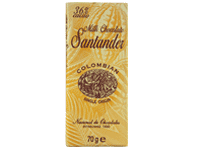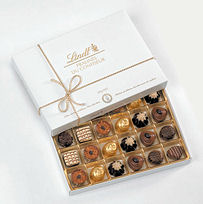About Chocolate
Single origin Chocolate
DID YOU KNOW?
The flavour profile of a single origin chocolate,made by one of the world's fine chocolate makers, can be as complex and specialist as a fine wine. Also, the term "single origin" should not be taken as an assurance the chocolate is necessarily of a high quality, as this of course depends on who is actually making the chocolate and what quality of cocoa they are using. For a true understanding of this term and to avoid being mislead by clever marketing and packaging, read on..
Definition
Single origin chocolate is so called because the cocoa beans used to create it are taken from a single source/origin, in some instances a single estate or plantation but in most instances a single country. It refers to the origination of the cocoa beans used to create the chocolate and not the finished chocolate itself. The source and use of certain cocoa allows the chocolate maker to create particularly charismatic flavour profiles within each bar and quite unique to the next.
Good and bad single origin chocolate
To say that a single origin chocolate therefore is a good chocolate would be incorrect. There are good and bad single origin chocolates just in the same way there are good and bad olive oils, wines, vinegars and so on. To address this issue is a little more complicated as it addresses many different aspects and processes in the creation of a good chocolate. For instance, a particular origin, due to its unique geographical position, soil, climate and immediate habitat may produce an exceptional crop of cocoa, but if this is then not correctly harvested, dried, roasted and handled by a true chocolate maker using only the best methods will amount to nothing. The same can be said of the particular variety of cocoa used, a single origin chocolate does not guarantee that the variety and grade of cocoa used is of a high or low quality, just the origin.
To fully understand what makes a great single origin chocolate is to inform yourself of all these variables and ultimately the reputation, integrity and craftsmanship of the chocolate maker. How do you do this? Well, we have spent years sourcing the worlds finest chocolate and learning all there is to know about its origins and manufacture. We do not have to market or promote our own chocolate and are completely independent to decide which brands to include in our collection, and which of course to recommend.
The sources of the best single origin chocolate
There are particular countries, such as Venezuela and Madagascar that are renowned for producing the finest cocoa in the world. Whilst this sort of statement may be used as a general rule of thumb it is a general statement none the less, and in certain instances may even be used to mislead the consumer, which I shall cover later.
As “Single Origin” can be as broad a description as describing that the cocoa used originates from a single country then this again is open to many variables. Many chocolate makers detail further the origin, such as the name of the plantation or estate and also the cocoa variety, this certainly informs the consumer that not only is the chocolate maker proud to display the quality of cocoa used to create the chocolate, they are even going as far to highlight the name of the plantation or estate, allowing us the opportunity to check its credentials if we so wished.
Often it is not possible for a chocolate maker to source fine flavour cocoa from one plantation alone due to the practicalities of supply and demand, also the way cocoa is sold on the world market. To buy cocoa originating from one country eliminates many supply problems that otherwise may happen from a single plantation or estate. A poor harvest, disease or natural disaster can affect a cocoa harvest as any other crop and so to limit the supply to one particular plantation requires a considerable gamble with the supply chain. Many of the top chocolate makers either own or manage the land on which the cocoa is grown to ensure as much control as possible and lessening the risk.
 Santanda Single Chocolate Bar 70g
Santanda Single Chocolate Bar 70g
The History of Chocolate and Cocoa
600 Culture and 1200 Chocolate War 1528 Sweet Plunder 1671 Blissful Accident 1677 A Royal Decree 1879 Melting Sweetness
A.D. 600 the Mayas undertook a massive migration which led this highly civilised people from Central America deep into the northern regions of
1000 Beans and Figures
From the very early days of cocoa the peoples of
By subjugating the Chimimeken and the Mayas, the Aztecs strengthened their supremacy in
1502 Columbus and the Cocoa bean
On his fourth voyage to America, Columbus landed on 30th July 1502 in Nicaragua and was the first European to discover cocoa beans. These were used by the natives as currency and also in the preparation of a delightful drink. But Columbus, who was still searching for the sea route to
1513 Payment in Beans
Hernando de Oviedo y
1519 A Spanish Bank
Hernando Cortez, who conquered part of
In 1528, Cortez brings back to
1609 The First Chocology
'Libro en el cual se trata
1615 Fruitful Marriage
The Spanish princess Anna of Austria marries Louis XIII and introduces, amongst other Spanish customs, the drinking of chocolate at the French court.
1657 A Frenchman in
1662 A Solomon of Chocolate
After Pope Pius V had found cocoa so unpleasant that he declared, in 1569, that "this drink does not break the fast", the supreme church of Rome became more and more tolerant towards the exquisite beverage. The question of the fast took on a new urgency. In 1662, Cardinal Brancaccio hands down the judgment of Solomon:"Liquidum non fragit jejunum." In other words:"Liquids (in the form of chocolate) do not break the fast." Clearly, one had to wait until Easter to indulge in the eating of chocolate. 1670 The Fate of a Seaman Helmsman Pedro Bravo do los Camerinos decides that he has had enough of Christian voyages of exploration and settles in the
A clumsy kitchen-boy drops a bowlful of almonds on the floor. The angry chef tries to box his ears and, in the process, spills a panful of hot, burnt sugar over the almonds. The Duke of Plesslis-Praslin, a marshal who is renowned as a gourmet, is waiting for his dessert. "What now?" thinks his personal chef and, in desperation, serves the marshal with the almonds covered with a coating of cooled sugar. The guest is delighted with the novel dessert and promptly gives his name to the new sweet. Not, however, the full name, but simply "Praslin". Since then this sweet has undergone many changes, including the development of the modern term "praline" from the original name.
1674 Roll Call
"At the Coffee Mill and Tobacco Roll" was the name of a famous
On the strength of a royal decree dated 1st November 1677,
1697 Premier in
Heinrich Escher, the mayor of
1704 Chocolate Tax
Towards the end of the 17th century, chocolate makes its appearance in
1711 Chocolate Migration
Emperor Charles VI transfers his court from
1720 Chocolateers
As early as 1720, the coffee-houses of
1747 No Hawkers
In the year 1747,
1755 Last but not Least
1780 First Factory
About the year 1780, the first machine-made chocolate is produced in
1792 Two from the Grisons in
The Josty brothers from the Grisons made a major contribution to the reputation of Swiss chocolate in
1797 Cautious Goethe
Johann Wolfgang von Goethe does not have much confidence in the Swiss hotel industry. For his tour of
1810 Top of the League
1819 Pioneers
The first Swiss chocolate factory is set up in a former mill near Vevey. The founder, Francois-Louis Cailler, had learned the secrets of the choco- late-making trade in
1822 Ornamental Plant
The Portuguese Jose Ferreira Gomes introduces the cocoa tree as an ornamental plant on the small
1857 The Swiss in Africa
Under the encouragement of the Portuguese Baron of Agua Ize, the culti- vation of cocoa passes from Principe on the neighbouring island of Sao Thome, and from there to the African continent. In
1875 With Milk
After eight years of experiment, the Swiss Daniel Peter puts the first milk chocolate on the market in 1875.
Rodolphe Lindt of
1900 Changes in Leadership












